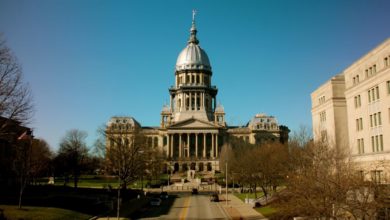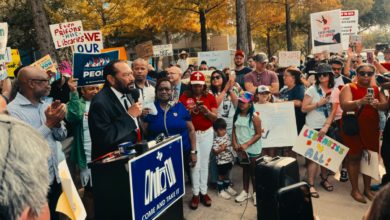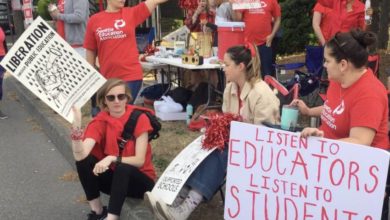The history of public education is inseparable from the class character of American society.
 |
As with other bourgeois-democratic revolutions, the American Revolution gave momentum to some popular reforms, including public education. The owners needed a work force that could manage and operate machinery in increasingly complex industries, as well as people who could perform administrative tasks. For this reason, the bourgeoisie supported a minimal level of public education.
By 1824, the first publicly funded high school was formed in the United States. By the beginning of the Civil War in 1861, three hundred high schools had been created. In 1874, when Michigan’s Supreme Court ruled that school districts must maintain a tax-supported public high school, secondary education became much more widely available. By 1890, there were 2,500 high schools in the United States, primarily located in urban areas.
Even after the Civil War, oppressed groups were excluded from public education or segregated into sub-standard schools; this was especially true for African Americans. Consequently, public education has been a field of constant struggle for the African American community. Many of the gains made in public education for all oppressed communities have resulted from this ongoing struggle.
Among the victories was the Supreme Court’s Brown v. Board of Education landmark decision in 1954. The court’s ruling declared unconstitutional the Jim Crow concept of “separate but equal.” The Supreme Court’s justices did not rule against segregation because they were suddenly overcome by progressive inclinations. African American parents and students forced a reversal in the policy of racial segregation through struggle. This reversal paved the way for integration.
Under capitalism, schools must perform in ways that are beneficial to the ruling class. Capitalism has no interest in educating the public to increase their knowledge and raise their consciousness.
However, capitalism does require that the vast majority of working-class children receive enough education to perform job responsibilities in the workplace—the bare minimum to make them effective wage slaves. The bourgeoisie also needs a relatively small number of highly skilled workers. The most privileged functionaries in capitalism often come from the ranks of the capitalist class itself.
School vouchers, charter schools
Today, a struggle over education continues between oppressed communities and the bourgeoisie. The former fights to maintain their access to public education; the latter wants to craft an education system better suited to its own needs.
Charter schools and school vouchers are the most prominent devices in the efforts to privatize public education. Both systems use millions of dollars of taxpayer money to weaken the system of public education.
School vouchers are promoted as a means for low-income families to provide an improved level of education for their children. Under the program, parents receive a voucher worth a set amount of money from the government. This voucher is to be used by parents to enroll their children in a private school of their choice.
Milwaukee instituted the first such school voucher program in 1990. And in 2004, Congress passed the first federally funded voucher program for Washington, D.C., schools.
Vouchers can be used at private schools exempt from the rules that apply to public schools. For example, Milwaukee’s private schools are freed from guidelines on hiring certified teachers, implementing testing standards, or publicly releasing student achievement data.
In many cases, the vouchers are not enough to pay the full tuition at private schools, so parents must pay for the balance. Vouchers do not cover the cost of transportation to and from school. Consequently, vouchers benefit primarily more affluent families who can get the state to subsidize part of their children’s education at private schools.
School voucher programs are promoted in very misleading ways. They are presented as an alternative to parents from low-income and oppressed communities facing the problems of substandard public education. In reality, the voucher system is an attack on public education. With vouchers, the state is no longer fully responsible for providing public education for everyone.
By funding private schools through public funds, teachers’ unions will also be weakened. These unions play an important role in the fight for public education and higher living standards for teachers.
According to the National Education Association, “Charter schools are publicly funded elementary or secondary schools that have been freed from some of the rules, regulations, and statutes that apply to other public schools.”
The first charter school law was passed by Minnesota in 1991. Nearly 3,600 charter schools have been launched in 40 states since the law passed. One of the motivating factors is the drive to employ more part-time and lower-paid, non-union teachers and staff.
Many charter schools require parents to volunteer at school and participate in school activities for a specific number of hours per school year. If parents do not participate or meet the required hours, the schools reserve the right to ask students to leave.
Many charter schools are not prepared to serve students with disabilities and discourage them from enrolling. They do not comply with federal special education statutes because these services are too costly to provide. By contrast, such discrimination in public schools is illegal.
The ruling class would like us to believe that charter schools outperform public schools. Yet, according to the recent “UCLA Charter School Study,” charter schools do not generate higher academic achievement, nor do they enroll more disadvantaged students. Smaller class sizes are made possible in charter schools by corporate contributions. However, this advantage is offset by having less qualified, non-certified and non-union teachers at charter schools.
Without a union, teachers at charter schools are asked to work longer school days, hold mandatory meetings during lunch time and after school, train other teachers, conduct counseling, and take on administrative tasks. All the while, there is no job security and principals can fire teachers for any reason.
‘No Child Left Behind’
In 2002, the Bush administration’s No Child Left Behind Act (NCLB) transformed federal education funding by attaching it to test score requirements. Through increased standardized testing, schools have to demonstrate “adequate yearly progress” (AYP). The AYP measures and ranks the performance of public schools. Under NCLB, states can now close or restructure “underperforming schools”—those that fail to meet the requirements established by the AYP. And the NCLB focus on testing clearly targets schools in low-income communities.
One option for schools that do not make the AYP on standardized tests is “reconstitution”—put bluntly, staff replacement. Other options include being closed down, converted into a charter, taken over by the state or managed by a private company.
Of course, the public school system is far from perfect. Decades after the Civil Rights struggle, many schools are still racially segregated for all intents and purposes, and the courts have struck down many local school board initiatives aimed at integrating schools.
Public schools largely depend upon local property taxation. Because schools that serve the poor are generally located in areas with low property values, poor children rarely get the same educational opportunities as children from more affluent families. Many people of color have lost faith in the public school system because schools that serve their communities tend to be substantially inferior to schools that serve affluent white communities.
Privatization seeks to dismantle the public education system in the interest of corporations, who would rather have workers’ tax dollars spent on more profitable priorities. But for the working class, the problems of education cannot be solved by privatization. To the contrary—funding for public education should be expanded with additional resources devoted to schools in the most oppressed communities.
As long as we live under capitalism, a constant struggle will be needed to prevent the ruling class from rolling back the gains already made in public education. Socialist countries, such as Cuba, have shown that high-quality public education for all of society is within our reach. Under socialism, workers will not have to fight against the state to preserve public education. Rather, the state will fight alongside the workers to expand and improve education.






